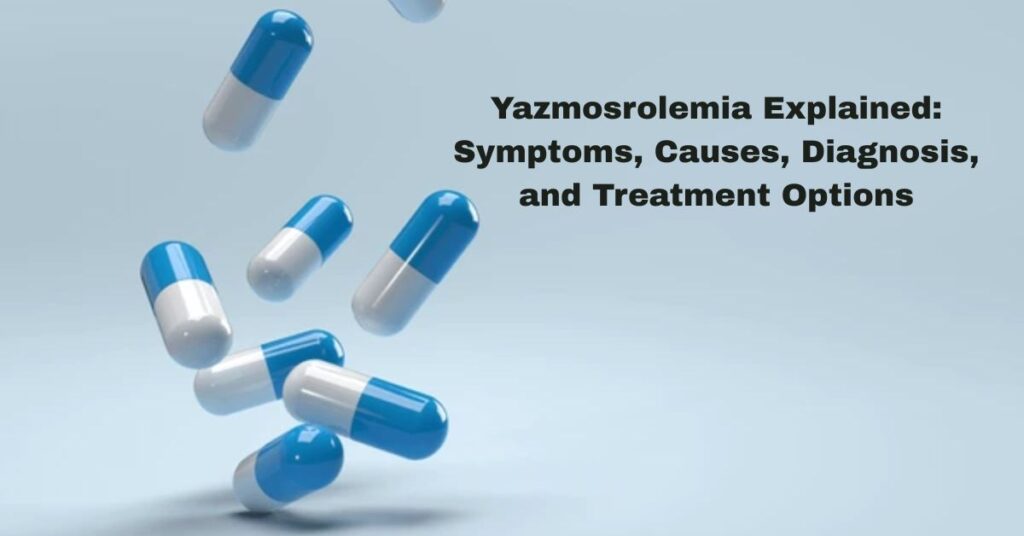Yazmosrolemia: Symptoms, Causes, and Treatment Explained is a topic that matters to people dealing with confusing health issues. This condition is often linked to rare illness signs like muscle weakness, joint pain, and chronic fatigue. It shares many symptoms with other autoimmune disease types, so it can be hard to diagnose. Doctors believe immune system disorder and inflammation play a big part in it.
Understanding the signs early and getting the right medical treatment can help manage this chronic condition. You’ll learn here about the symptoms, causes, diagnosis, and how to live with it. There’s also talk about whether Yazmosrolemia might one day be a recognized illness in modern medicine.
What is Yazmosrolemia?
Yazmosrolemia is believed to be a rare illness that affects the muscles, nerves, and joints. It’s often connected to an autoimmune disease, where the body’s own defense system makes a mistake. Instead of fighting viruses, it attacks healthy tissues. This wrong immune response causes pain, weakness, and even brain fog.
It’s still not an official diagnosis, but some doctors and researchers think it could become one. Symptoms often look like those of neurological disorder, fibromyalgia, or lupus. People usually visit many doctors before getting a clear answer. Still, the need for more research is clear.
Symptoms to Watch For
People with Yazmosrolemia often face ongoing muscle weakness and chronic fatigue. These aren’t the kind of tiredness that goes away with sleep. This is fatigue not relieved by rest, which makes daily life hard. Some may also feel joint pain, balance problems, or cognitive impairment. They may forget things or find it hard to focus.
These physical symptoms may come and go. Doctors call that autoimmune flare-ups. Each person may feel them differently. That’s why symptom tracking is helpful. Keep a diary of how you feel every day. That way, it’s easier for doctors to spot patterns.
Read More About: About ZO35-G25DA74 Model TV: Features, Performance, and User Benefits
Causes and Risk Factors
No one knows the exact cause of Yazmosrolemia. But many believe genetic predisposition and environmental triggers play a role. If someone in your family has an autoimmune disease, your chances may be higher. Things like infection, trauma, or toxins could also set it off. These are called stress-related triggers.
Another factor may be immune system dysfunction. This means your immune cells start acting the wrong way. They attack instead of protect. This leads to inflammation, which causes pain and tissue damage over time.
How Is Yazmosrolemia Diagnosed?
Doctors use a mix of diagnostic tests to figure out what’s wrong. They’ll begin with a medical evaluation and a full health history. After that, they might order blood work to check for inflammation markers or signs of an autoimmune attack.
Imaging like MRI or CT can check for muscle or nerve damage. Sometimes, doctors use electromyography (EMG) to measure how your muscles and nerves work. In rare cases, a biopsy confirmation is needed to check tissue under a microscope. Getting an early diagnosis gives you a better chance to manage the illness.
Treatment Options
There’s no cure, but treatments can help manage symptoms and slow the disease progression. The first line of defense is usually steroid medication and other drugs that calm the immune system. These reduce inflammation and improve comfort.
Doctors also use pain management techniques and rehabilitation therapy to help patients stay mobile. A full medical treatment plan may include medications, therapy, and mental health support. It’s a holistic approach that covers both the body and the mind.
Living with Yazmosrolemia
Life with Yazmosrolemia is not easy, but it can be managed. The key is lifestyle changes and building good coping strategies. Things like rest, stretching, and a healthy diet can help. So can mild exercise and staying in touch with your doctor.
Support from others also matters. Joining support groups gives you emotional support and helps reduce stress. Talking to a counselor can help you face mental health issues that come with being sick all the time. Taking care of your mind is just as important as your body.
Root Causes: What Triggers Yazmosrolemia?
Experts think the root causes lie in your genes and how they react to the world around you. A mix of genetic predisposition and environmental triggers may cause the immune system to go wrong. In many cases, a viral infection or even a big shock to your system can act as a trigger.
Once the immune system dysfunction starts, it may not stop. This can cause autoimmune flare-ups, where the immune system keeps making the same mistake. Over time, this creates pain, weakness, and tissue damage.
Symptoms: Recognizing the Warning Signs
Symptoms often begin slowly. You might first notice chronic fatigue that doesn’t improve, or mild muscle weakness. As time passes, this can lead to problems with movement or even thinking. Some patients report cognitive impairment, like forgetting words or losing focus.
Since it shares traits with other illnesses, Yazmosrolemia can confuse even good doctors. That’s why nerve function testing and symptom tracking are so useful. They help tell Yazmosrolemia apart from other chronic conditions.
Diagnosis: How Is Yazmosrolemia Identified?
The process usually starts with your doctor asking questions. After the medical evaluation, blood samples might be taken to look for inflammation markers and signs of an autoimmune attack. These are often the first clues.
If results are unclear, more tests follow. Electromyography (EMG) checks how nerves talk to muscles. If needed, doctors may ask for a biopsy confirmation. All of this helps rule out other causes and confirm the problem.
Treatment Options for Yazmosrolemia
Doctors work to reduce pain and stop more damage. Medicines like steroid medication help quiet the immune system. That cuts down on inflammation and pain. Each person gets a personalized care plan based on how severe their symptoms are.
Along with meds, doctors recommend physical therapy and rehabilitation therapy. These help you stay strong and active. Eating well and resting also make a big difference. Combining all these makes life more manageable.
Hypothetical Symptoms of Yazmosrolemia
If Yazmosrolemia were officially recognized, its symptoms might include steady muscle weakness, deep fatigue not relieved by rest, and recurring joint pain. People might also face cognitive impairment and chronic fatigue daily.
It may also affect the nerves, causing neurological disorder symptoms like numbness or dizziness. Some could feel constant flu-like symptoms, even when not sick. These signs match those of many known autoimmune disease types.
Read More About: Can Laturedrianeuro Spread in 2025? Risk Explained in This Guide
Could Yazmosrolemia Be a Real Diagnosis One Day?
Yazmosrolemia might one day be seen as a real condition if research keeps growing. Many people have symptoms that don’t fit in a box. This could be a step toward giving them answers. Current tools like diagnostic tests and patient records may help doctors spot a clear pattern.
It could be added to the list of chronic conditions if enough proof is found. Better understanding might also lead to better medical treatment. That’s why sharing symptoms and pushing for studies matters.
| Symptom | Related Test |
| Muscle Weakness | Electromyography (EMG) |
| Chronic Fatigue | Blood Test for Inflammation |
| Joint Pain | MRI or CT Scan |
| Cognitive Impairment | Neuro Evaluation |
| Nerve Pain | Nerve Function Testing |
| Skin Inflammation | Biopsy Confirmation |
FAQs
What is Yazmosrolemia?
Yazmosrolemia is a rare health condition that may affect the muscles, nerves, and brain. It’s linked to the immune system attacking the body’s own tissues.
What are the symptoms of Yazmosrolemia?
People with Yazmosrolemia often feel muscle weakness, joint pain, tiredness that doesn’t go away, and sometimes brain fog or memory issues.
How is Yazmosrolemia diagnosed?
Doctors use blood tests, imaging scans, nerve tests like EMG, and sometimes a biopsy to check for signs of Yazmosrolemia and rule out other diseases.
Can Yazmosrolemia be treated?
There’s no cure yet, but Yazmosrolemia can be managed with medication, physical therapy, lifestyle changes, and emotional support.
Conclusion
Yazmosrolemia is a serious health condition that may cause muscle weakness, chronic fatigue, and joint pain. It also affects the brain and nerves, leading to cognitive problems. Doctors believe yazmosrolemia is linked to the immune system, where the body attacks itself by mistake. While it is not fully understood yet, many people show signs that match this illness. Getting help early and starting the right medical care can make daily life easier.
Living with yazmosrolemia can be hard, but support and the right treatment plan can help a lot. Medicines, rest, exercise, and emotional care all play a big part in staying healthy. It is important to follow what your doctor says and take good care of your body and mind every day.

Gabriel Dawnson is a spiritual writer, dream analyst, and seeker of higher wisdom. With a deep passion for uncovering the hidden meanings behind dreams and spiritual symbols, he has dedicated his work to helping others navigate their spiritual journeys.
As the lead author of SpiritualHubz, Gabriel explores topics such as dream interpretations, angelic messages, numerology, and mystical symbolism. His writings are infused with profound insights, drawing from ancient wisdom, psychological perspectives, and modern spiritual practices.
Gabriel believes that every dream carries a message and that spirituality is a guiding force in understanding life’s deeper purpose. Through his articles, he aims to enlighten, inspire, and empower readers to connect with their inner selves and the universe.



